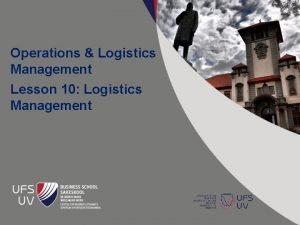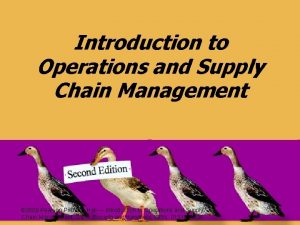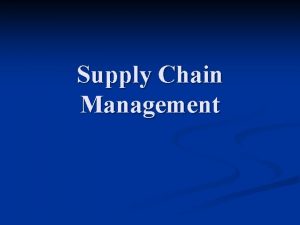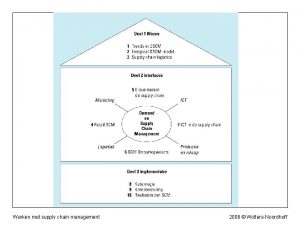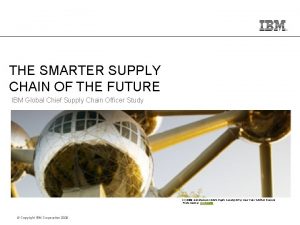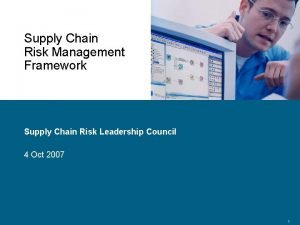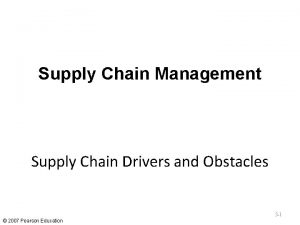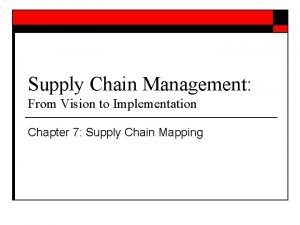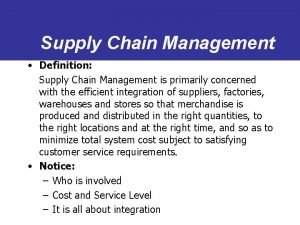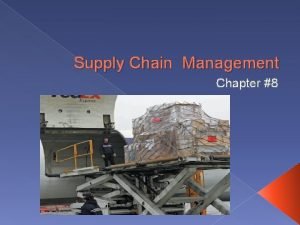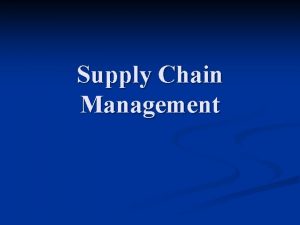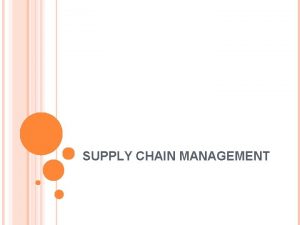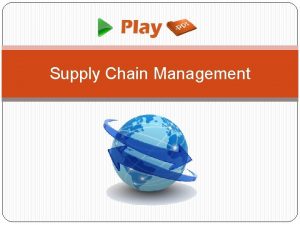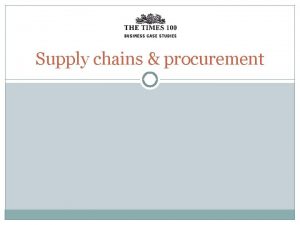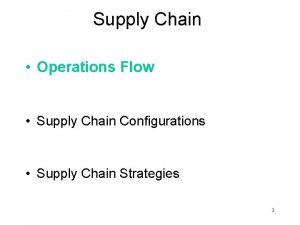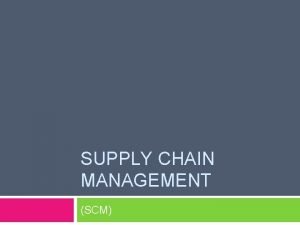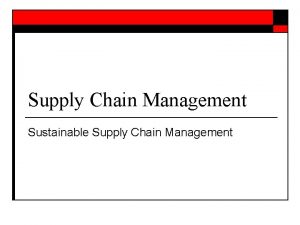Supply Chain Management Introduction to Supply Chain Management
















- Slides: 16

Supply Chain Management

Introduction to Supply Chain Management (SCM) �A supply chain is the system of organizations, people, activities, information and resources involved in moving a product or service from supplier to customer. � An integrated group of processes to “source, ” “make, ” and “deliver” products. � It is the process of planning, implementing and controlling the operations of the supply chain with the purpose to satisfy customer requirements as efficiently as possible. � Supply chain management manages all movement and storage of raw materials, work-in-process inventory, and finished goods from point-of origin to point-of-consumption.

Definition of SCM � According to the Supply Chain Council, U. S. A. , “ Supply chain Management encompasses every effort involved in producing and delivering a final product or service, from the supplier’s supplier to the customer‘s customer. ” � Importantly, it also includes managing supply and demand, sourcing raw materials and parts, manufacturing and assembly, warehousing and inventory tracking, order entry an order management, distribution across all channels, and delivery to the customer.

Supply Chain Supplier Manufacture r Distributor Retailer Customers

Division of SCM Supply chain management flows can be divided into two main flows: � Downward Flow: it indicates the movement of Raw Material, WIP and Finished goods from a supplier towards customer. � Upward Flow: it indicates information regarding goods, delivery schedules, customer needs, tastes and preferences from customer to supplier’s side. It also includes transfer of money and credits and ownership of titles etc.

Supply Chain Flow

Characteristics of SCM Focus on Customer: Supply Chain Management is the process for making available the goods to customers at competitive prices. It ensures right quantity, right quality, right location, right time and right price for the customer. Responsible for Multiple Flows: There are two types of flow in supply chain network i. e. downward and upward. Downward flow is of physical product from vendor to customer and upward flow from customer to vendor includes Information and money.

Participants: It involves various participants such as suppliers, manufacturers, distributors, wholesalers, retailers and customers. All these participants and their coordinated activities are the focus area of the supply chain management. Multiple Activity: It does not comprise only traditional function of any business such as purchase, inventory management, transportation or logistics, distribution but the activities such as new product development , activities have also emerged as focus area of supply chain management recently. Ensures coordination of participants: Ensuring collaboration and coordination of all the participants and activities within the supply chain is a vital requirement for the success of supply chain management.

Components of SCM Participants Process Activities

Participants In SCM Supplier Supply Chain Service Provider Manufactu rer Customers Distributors Retailers Wholesalers

Process of SCM Planning Sources of material Physical Distribution Return Manufacturing

Activities/Functions of SCM Demand Forecasting Purchase/Material Handling New Product Design Inventory Management Logistic Management Packaging Distribution Customer Relationship Management (CRM) Marketing

Advantages of SCM � Reliable Forecasting: It helps in making an estimate which is close to actual. Making a � Reduction of supply chain chest: It will help in overall reduction in cost of product. � Increased Customer Satisfaction: Customer will get best quality goods and services at � Shorter lead time: Lead time is required by a firm in converting raw material into finished � Reduced investment in inventory: Accurate forecasting of demand will result in � Raise Output: The streamline & centralized distribution strategy of supply chain management software make it more reliable for end users and give more accurate output results. � Order Management: Supply chain software can dramatically accelerate the execution of the entire order-to-delivery cycle by helping companies to more productively generate and track sales orders. correct estimate is important because if production exceeds the demand, it will result in increased carrying cost if inventory. reasonable cost. goods on the one hand delivering finished goods from producer to ultimate consumer on the other. maintaining optimum stock level. It will result in releasing the capital locked in the excess reserve of inventory created by the organization.

Limitations of SCM • Complex of activities: Supply Chain management process involves number of activities and participants. • Increased chances of error: As there are number of activities and participants involved in a supply chain, chances of error increase. • Dependence on outside consultants: There is process of many outside agencies for specialized jobs such as material handling logistics, design companies, packing consultants, marketing and advertising companies. • Heavy investment of resources: It requires large investments of time, money and resources. The small producers and business sometimes find it beyond their financial capacity to implement the same.

Challenges of an Effective SCM � Volatility of customer demand: The customer these days have become more demanding and want goods of their choice at lowest possible cost delivered to their doorsteps in no time. It poses a challenge in front of the companies to satisfy the customers. � Globalization: The advent of e-commerce has turned business into a global village where anyone from anywhere is potential seller. It has led to increased complexity in the already complex supply chain process as it leads to more delivery time. � Difficult to integrate huge amount of information and data: It is very challenging to analyze, examine and obtain a complete picture from that data. Hence, the collected data may not be clear. � Over reliance on past data: SCM generally rely more on past data to make future estimate. The estimates are made on certain assumptions that may or may not hold true in future.

 Logistics management introduction
Logistics management introduction Introduction to operations and supply chain management
Introduction to operations and supply chain management Matching supply with demand
Matching supply with demand What is crm in supply chain management
What is crm in supply chain management Contemporary issues in operations management ppt
Contemporary issues in operations management ppt What is the correct sequence in supply chain
What is the correct sequence in supply chain What is logistics management
What is logistics management Grazing food chain diagram
Grazing food chain diagram Werken met supply chain management noordhoff
Werken met supply chain management noordhoff Ibm supply chain strategy
Ibm supply chain strategy Supply chain risk management framework
Supply chain risk management framework Supply chain risk management framework
Supply chain risk management framework Risk assessment likelihood
Risk assessment likelihood Drivers of supply chain management
Drivers of supply chain management Pipeline in supply chain
Pipeline in supply chain Supply chain management meaning and definition
Supply chain management meaning and definition Supply chain upstream and downstream
Supply chain upstream and downstream
